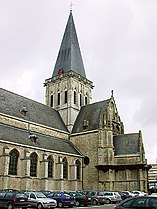Asse
| Asse | |||
|---|---|---|---|
| Municipality | |||

Sint-Martinuskerk
|
|||
|
|||
| Location in Belgium | |||
| Coordinates: 50°54′N 04°12′E / 50.900°N 4.200°ECoordinates: 50°54′N 04°12′E / 50.900°N 4.200°E | |||
| Country | Belgium | ||
| Community | Flemish Community | ||
| Region | Flemish Region | ||
| Province | Flemish Brabant | ||
| Arrondissement | Halle-Vilvoorde | ||
| Government | |||
| • Mayor | Koen Van Elsen (CD&V) | ||
| • Governing party/ies | CD&V, VLD, SP.A | ||
| Area | |||
| • Total | 49.64 km2 (19.17 sq mi) | ||
| Population (1 January 2016) | |||
| • Total | 32,402 | ||
| • Density | 650/km2 (1,700/sq mi) | ||
| Postal codes | 1730, 1731 | ||
| Area codes | 052 - 02 | ||
| Website | www.asse.be | ||
Asse (Dutch pronunciation: [ˈɑsə]) is a municipality located in the Belgian province of Flemish Brabant. It comprises the towns of Asse proper, Bekkerzeel, Kobbegem, Mollem, Relegem and Zellik. On January 1, 2006, Asse had a total population of 29,191. The total area is 49.64 km² which gives a population density of 588 inhabitants per km².
Asse (formerly spelt "Assche") was probably inhabited by the Celtic tribe of the Nervii. The name itself probably comes from a pre-Celtic word meaning "water" (cf Esch-, Es- and Axe- prefixes elsewhere in Europe). It was probably inhabited from an early date; stone tools have been found in various locations. The fertility of the soil and the relief which rises above the wetter plains of present-day Flanders would also suggest that his would have been an early area of settlement.
From the middle of the first century, a Roman military road connected it to the capital of the Roman province of Nervii in Bavay (Bagacum Nerviorum). It continued northwards as far as the naval port at present-day Rumst, with various side roads to the East and West. It is possible that there was a Roman military camp to the south east of the present town centre in what is now known as "borgstad", though its role has not been clearly proven.
What is sure is that Asse grew to be a substantial settlement or vicus at an, at least locally, important road junction. Though no Roman buildings are extant there have been frequent archaeological finds including in 2007 a pottery and in 2008 a section of a (perhaps intra-urban) Roman road. It is possible that there was local cult of Epona as a large number of clay horse figurines, presumably votive offerings, have been found.
...
Wikipedia




